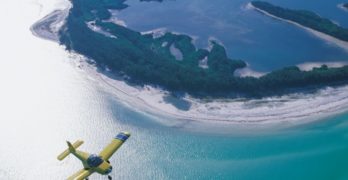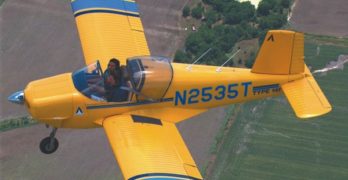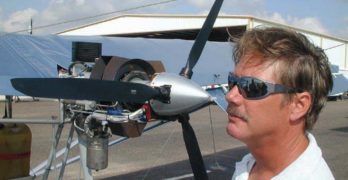All Revved and Everywhere to Go
This vintage design with a big Jabiru engine is an impressive performer.
Since its reintroduction to the aviation community by IndUS Aviation, John Thorp’s T-211 is generating more attention than at any time since he first designed the airplane.
While John worked on large aircraft, like the Navy patrol bomber P2V Neptune, he focused most of his career on small, sporty aircraft. He began designing a two-place light aircraft in the 1930s. By the 1950s his T-10 Sky Skooter powered by a 50-hp Franklin 2AC-99 engine evolved into the T-111 with a 75-hp Lycoming engine. Later it became the T-211, with a Continental O-200. It is this last version of the T-211 that IndUS now offers as a standard category aircraft. IndUS is also planning to offer the model as a light-sport aircraft (LSA) with a Jabiru 3300 engine, affectionately named the Thorpedo for its improved performance.
Search Results for : Texas aircraft
Not finding exactly what you expected? Try our advanced search option.
Select a manufacturer to go straight to all our content about that manufacturer.
Select an aircraft model to go straight to all our content about that model.
Thorp T-211
Thorp T-211 Sport E
From the world of general aviation aircraft comes an entry to the proposed Light-Sport Aircraft (LSA) category. Presently known as the Thorp T-211, the all-metal airplane will be called the Thorp T-211 Sport E when it makes its debut as a light-sport aircraft.
Famed designer John Thorp is perhaps best known for his work leading to the Piper Cherokee series and the T-18 homebuilt. His work on a design that became the T-211 started back in the 1940s before general aviation planes had transportation as their primary goal. When the T-211 was first created – as the T-11 Skooter and later the T-111 – it was intended to become competition for the Cessna 150. The T-211 is a light plane, tipping the scales at hundreds of pounds less than Cessna’s smallest model and so it was expected to perform better.
Under new management since 2003, Thorp’s design is ready to make the leap to the Sport E.
Product Lines – July 1999
ST. PAUL, MINN., — The glare of spotlights this month turns to GW Meadow’s U.S. Nationals which took place at Quest Air the week after Malcolm Jones’ Wallaby Open concluded. ••• Weather wasn’t quite as cooperative and the organization was different, but the U.S. Nationals are now history and Jim Lee is our national champion, edging out top-ranked Mike Barber by a mere seven points (nothing, really, in the course of a whole contest week). Prior to the two Florida events, Barber had been #1 ranked in the U.S. team scheme though new stats will now be needed. • Neither man outdid the dynamic duo of Manfred Ruhmer and Oleg Bondarchuk (ranked #4 and #1 in the world scheme prior to these two meets). In addition, web writer Davis Straub also indicated several pilots from Brazil did well… as all these non-USA pilots had done at the Wallaby meet. • All in all, Florida was host to two grand events and both are angling for a repeat next year, so say the rumor mills.
Product Lines – June 1996
ST. PAUL, MINN — As we circle into the soaring season, I have an eclectic group of topics. But first… ••• Like it or not, it appears some kind of FAA rule change is coming. Our reps to the ARAC group meeting with FAA are Dennis Pagen and Mike Meier, two solid individuals who will present our position well. It’s simply too early in the process to report what’s happening as the game could change following the response FAA requested of the ARAC industry group. Nonetheless, it appears certain that some changes are imminent. If more information is available by next month’s column I’ll provide more on this subject. Meanwhile, back at the grassroots… ••• I’m personally pleased (being financially involved with the project) to report that the Cumulus ultralight motorglider flew. Under development since 1993, the pace quickened in the last half of 1995 and the motorglider flew in March 1996.
Product Lines – August 1995
ST. PAUL, MINN. — In this summer edition of "PL," I want to add a few more places you can fly in what I view to be a subtly but surely changing landscape. Once you leave the big mountains and big air of the west, towing takes on more impact in delivering flight to hang glider pilots. However, towing is also moving west as trikes catch on as tugs and as ultralight sailplanes add dimension to areas formerly occupied only by flex wings. ••• This month, I’ll touch on five more sites where you can pursue towing. In the east but not in Florida or Texas (where towing is well established), we find two Midwest centers, one north, one south. • Well known to hang gliding pilots around the world is Matt Taber’s Lookout Mountain. Matt is well into his second decade running one of the largest and most developed sites in the country.
Product Lines – November 1994
ST. PAUL, MINN. — Ready or not, another holiday season is upon us. We’ll look at some gift ideas… which means you should be sure those who buy gifts for YOU know about the nifty things you want. Face it. Many spouses feel hang glider pilots are hard to buy for; they only want expensive stuff. In the next couple issues of "Product Lines," I’ll try to highlight some more gift-priced items. But first… ••• Some results have been tabulated from the survey card that came in your October issue. Over 300 cards arrived in a short period, a large enough sample to get reliable information. • Asked if you believe hang gliding has a growth period ahead, a split response resulted. Slightly more than half (54%) feel it can grow, but 46% apparently see obstacles. • When asked if you desire to see hang gliding grow, an overwhelming 86% answered yes, with 14% not inviting growth.
Product Lines – October 01
ST. PAUL, MINN., — For the first time I can remember, in 22 years of writing "Product Lines," my column had to be substantially changed after it left my desk (or, these days, my computer desktop). News from Peter Radman of Altair cast doubt about the future of the newest American hang gliding producer. Fortunately for Peter and the old organization, the news improved… • Radman wrote on August 26th: "Basically my original news was that Altair was ceasing operations. The update is that Altair has sold operations to [a new company called] US Altair, led by Steve and Marcia Schuster who are continuing to manufactuer the Predator and Saturn from facilities in Calfornia. A second company, Altair Industries LLC headed by Ivan Mrazek will continue to market the ATOS from facilities in Utah." Peter didn’t want to say more as he "no longer has any vested interest beyond personal interest." However, he added, "I see this as a positive development.
Product Lines – March 03
St. Paul, Minn. — Welcome to a new era for your magazine. After two tests and two surveys of the membership, USHGA has launched its new combined magazine. s I touched on this last month as I congratulated Gil Dodgen for his 25 years of service. But the magazine you are holding is indeed the most significant physical product of USHGA. Hope you’re enjoying the new look. lll These magazine changes come amid another sweeping change in American light aircraft operation. FAA is expected to release its new Sport Pilot and Light Sport Aircraft rule in the summer or fall of 2003. Many European powered aircraft makers are paying very close attention to this development as they see a golden opportunity to enter the world’s largest aviation marketplace. True, hang gliders and paragliders are well protected from the heavy hand of the law by virtue of the USA’s simple Part 103 rule which will NOT change.
Copperstate’s 30th Anniversary
Copperstate celebrates its 30th anniversary at a promising new venue.
That’s the dustiest place on Earth!” the pilot said upon returning from Phoenix Regional Airport in late 2001. John Kemmeries, a Phoenix-based ultralight entrepreneur, had sent the pilot to check out the proposed site for the Copperstate regional fly-in. The pilot’s reconnaissance report suggested a dry and dirty venue for the Arizona fly-in, but he had no way of knowing the event organizer’s vision.
As I approached the area in BRS’s Cessna 172 Hawk XP for the 2002 fly-in, I found myself searching vainly for an airstrip among the desert’s uniform brown color. As the GPS led me along, I suddenly saw a large swatch of green dotted with colored tents. My uncertainty vanished; the site stood out like the proverbial sore thumb.
Welcome to the new, improved Copperstate as created by thousands of volunteer man-hours and the support of a local land owner.
Turbines for Ultralights?
Just when FAA officials believe they have it figured out, individual actions can introduce new questions. I’m referring to the light-sport aircraft category of new rulemaking proposed by the aviation agency.
Consider the turbine engine. Why, you may ask, is turbine power the subject for a column that focuses on the lightest and slowest aircraft? The answer is that turbine engines are actually being used on the these aircraft, and they may be the right power for the use intended.
Turbine Tug
For two decades, hang gliders have been towed aloft by specially built ultralights. Aircraft like Bobby Bailey’s Dragonfly have succeeded at launching hang glider pilots who live in flat areas like Florida. They don’t need mountains. Just give them a Rotax engine and they’ll take to the skies in swarms.
Witness the spring ritual of dual hang gliding competitions in central Florida. Each year as the Sun ‘n Fun fly-in ends, pilots converge from all over the world.




